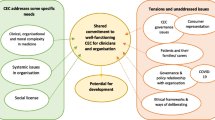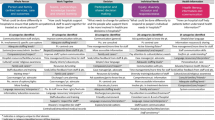Abstract
The philosophy of patient-centred care has become widely embraced but its implementation is dependent on interrelated factors. A factor that has received limited attention is the role of policy tools. In Ontario, one method government can use to promote healthcare priorities is through health regulatory colleges, which set the standard of practice for health professionals. The degree to which government policy in support of patient-centered care has influenced the direction provided by health regulatory colleges to their members, and ultimately impacted actual patient care, remains unclear. This study investigates the extent to which Ontario’s health regulatory colleges have provided explicit written guidance to members related to the importance of patient-centred care. It also explores applied and theoretical explanations that may further our understanding of why patient-centred care has not been more fully embraced. Findings reveal that guidance provided by Ontario’s health regulatory colleges varies widely. Institutional barriers and the choice of policy tools for disseminating government preferences may hinder full implementation of the principles of patient-centred care. More fully understanding the role health regulatory colleges’ play in facilitating the implementation of health policy will contribute positively to dialogue and to efforts to achieve positive health system reforms.
Similar content being viewed by others
References
Alford, R. R. (1977). Health care politics: Ideological and interest group barriers to reform. Chicago: University of Chicago Press.
Bauman, A. E., Fardy, H. J., & Harris, P. G. (2003). Getting it right: Why bother with patient-centred care? Medical Journal of Australia,179(5), 253–256.
Berwick, D. M. (2003). Disseminating innovations in health care. Journal of the American Medical Association,289(15), 1969–1975.
British Columbia, Ministry of Health. Setting Priorities for the B.C. Health System. (2014). Retrieved April 26, 2017, http://www.health.gov.bc.ca/library/publications/year/2014/Setting-priorities-BC-Health-Feb14.pdf.
Dal Bó, E. (2006). Regulatory capture: A review. Oxford Review of Economic Policy,22(2), 203–225.
Epstein, R. M., Fiscella, K., Lesser, C. S., & Stange, K. C. (2010). Why the nation needs a policy push on patient-centered health care. Health Affairs,29(8), 1489–1495.
Fix, G. M., VanDeusen, L. C., Bolton, R. E., Hill, J. N., Mueller, N., LaVela, S. L., et al. (2017). Patient-centred care is a way of doing things: How healthcare employees conceptualize patient-centred care. Health Expectations,00, 1–8.
Frampton, S., Guastello, S., Brady, C., Hale, M., Horowitz, S., Smith, S. B., et al. (2008). Patient-centered care improvement guide. Retrieved April 26, 2017, http://planetree.org/patient-centered-care-improvement-guide.
Galvin, E., Boyers, L., Schwartz, P. K., Jones, M. W., Mooney, P., Warwick, J., et al. (2000). Challenging the precepts of family-centered care: Testing a philosophy. Pediatric Nursing,26(6), 625–632.
Government of Nova Scotia. (2013). Model of care initiative in Nova Scotia. Retrieved April 26, 2017, https://novascotia.ca/dhw/MOCINS.
Government of Saskatchewan. Patient- and family-centred care. Retrieved April 26, 2017, https://www.saskatchewan.ca/government/health-care-administration-and-provider-resources/saskatchewan-health-initiatives/patient-and-family-centred-care#best-practices.
Health Quality Ontario. (2015). Quality improvement. Accessed April 24, 2017, http://www.hqontario.ca/Quality-Improvement/Quality-Improvement-Plans.
Heath Professions Regulatory Advisory Council. (2008). An interim report to the Minister of Health and long-term care on mechanisms to facilitate and support interprofessional collaboration among health colleges and regulated health professionals. Retrieved April 26, 2017, http://www.hprac.org/en/reports/archivedreports.asp.
Heath Professions Regulatory Advisory Council. (2008). A report to the Minister of Health and long-term care on the health profession regulatory colleges’ patient relations programs. Retrieved April 24, 2017, http://www.hprac.org/en/reports/resources/hprac-PatientRelationsReportMay_08EnglishPDF.pdf.
Heath Regulatory Professions Advisory Council. (2009). Critical links: Transforming and supporting patient care. Retrieved April 26, 2017, www.hprac.org/en/reports/resources/hpraccriticallinksenglishjan_09.pdf.
Herbert, C. P. (2005). Changing the culture: Interprofessional education for collaborative patient-centred practice in Canada. Journal of Interprofessional Care,19(s1), 1–4.
Kornai, J., Mátyás, L., & Roland, G. (Eds.). (2008). Institutional change and economic behaviour. New York: Palgrave Macmillan.
Kreindler, S. A. (2013). The politics of patient-centred care. Health Expectations,18, 1139–1150.
Laffont, J. J., & Tirole, J. (1991). The politics of government decision-making: A theory of regulatory capture. The Quarterly Journal of Economics,106(4), 1089–1127.
Luxford, K., Safran, D. G., & Delbanco, T. (2011). Promoting patient-centered care: a qualitative study of facilitators and barriers in healthcare organizations with a reputation for improving the patient experience. International Journal of Quality in Health Care,23(5), 510–515.
Naldemirci, Ö., Wolf, A., Elam, M., Lydahl, D., Moore, L., & Britten, N. (2017). Deliberate and emergent strategies for implementing person-centred care: A qualitative interview study with researchers, professionals and patients. BMC Health Services Research,17(1), 527.
Ontario Association of Community Care Access Centres. (2015) Ensuring the success of the coordinated delivery of personal support services by CCAC and CSS Agencies. Retrieved April 26, 2017, http://hssontario.ca/fr/News/Documents1/Ensuring%20the%20Success%20of%20Shared%20Provision%20of%20PSS%20-%20OACCAC%20-%20December%202015.pdf.
Ontario Hospital Association. Ontario Hospital Association submission on patients first: A proposal to strengthen patient-centred health care in Ontario. (2016). Retrieved April 26, 2017, https://www.oha.com/Legislative%20and%20Legal%20Issues%20Documents1/Patients%20First%20Submission%20-%20Reprinted%20May%202016.pdf.
Ontario, Ministry of Health and Long-Term Care. (2015). Patients first: A proposal to strengthen patient-centred health care in Ontario. Retrieved April 26, 2017, http://www.health.gov.on.ca/en/news/bulletin/2015/hb_20151217.aspx.
Ontario, Ministry of Health and Long-Term Care. (2015). Excellent care for all. Retrieved April 26, 2017, http://health.gov.on.ca/en/pro/programs/ecfa.
Rogers, E. M. (2003). Diffusion of innovations (5th ed.). New York: Free Press.
Scott, T. I. M., Mannion, R., Davies, H. T., & Marshall, M. N. (2003). Implementing culture change in health care: Theory and practice. International Journal of Qualitative Health Care,15(2), 111–118.
Shaller, D. (2007). Patient-centered care: What does it take? (pp. 1–26). New York: Commonwealth Fund.
Sidani, S., Reeves, S., Hurlock-Chorostecki, C., van Soeren, M., Fox, M., & Collins, L. (2017). Exploring differences in patient-centered practices among healthcare professionals in acute care settings. Journal of Health Communication,00, 1–8.
Stewart, M. (2001). Towards a global definition of patient centred care. British Medical Journal,322(7284), 444–445.
Tanenbaum, S. J. (2015). What is patient-centred care? A typology of models and missions. Health Care Analysis,23, 272–287.
Wilkins, S., Pollock, N., Rochon, S., & Law, M. (2001). Implementing client-centred practice: Why is it so difficult to do? Canadian Journal of Occupational Therapy,68(2), 70–79.
Author information
Authors and Affiliations
Corresponding author
Additional information
Publisher's Note
Springer Nature remains neutral with regard to jurisdictional claims in published maps and institutional affiliations.
Rights and permissions
About this article
Cite this article
Randall, G.E., Wakefield, P.A., Barr, N.G. et al. Barriers to Implementing Patient-Centred Care: An Exploration of Guidance Provided by Ontario’s Health Regulatory Colleges. Health Care Anal 28, 62–72 (2020). https://doi.org/10.1007/s10728-019-00386-6
Published:
Issue Date:
DOI: https://doi.org/10.1007/s10728-019-00386-6




